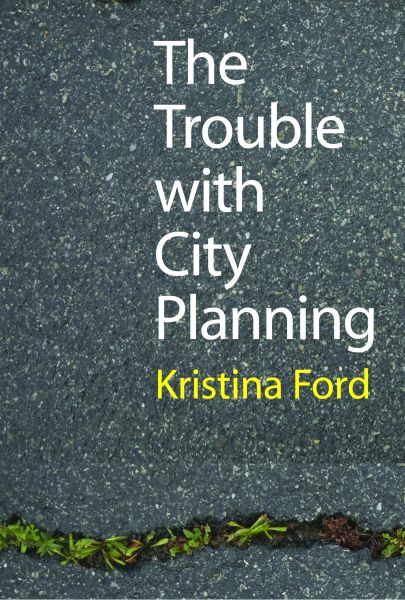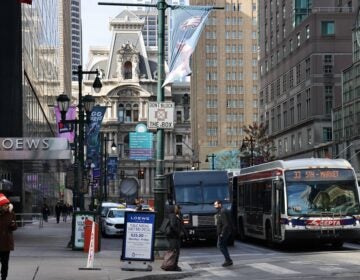The Trouble with City Planning
A few months ago, PlanPhilly contributor Thomas Walsh and I toured a part of New Orleans’ Lower Ninth Ward that’s commonly become known as the area with the “Brad Pitt houses.”
We were presented with a surreal landscape: about 20 starchitect-designed houses, painted in tasteful hues and sporting dramatic angles and uber-green features, lay sprinkled among acres of desolation. The effect was as if knockout roses had suddenly taken blossom on their own accord in a weedy inner city lot.
Interspersed between these inspiring homes were dozens of slab foundations. They were all that remained of the dozens of flood-ravaged houses that had been demolished.
Coming across a photo of a similar sight in the local newspaper got Kristina Ford thinking about a better way. Three years had passed since Hurricane Katrina, she notes near the end of her new book, “The Trouble with City Planning” (Yale University Press), and still the city “did not have a reliable plan.”
As we observe the fifth anniversary of the hurricane and the subsequent levee breaches, the city has considered, dismissed, or half-heartedly enacted a half-dozen different plans. The whole affair has led Ford, who served as the city’s planning director from 1992 to 2000, to consider the “trouble” that hinders the planning process.
In a nutshell, she writes, the problem is a “failure of influence” attributable to three factors. Plans aren’t easily grasped by the public, they don’t take advantage of the real ways in which citizens can provide valuable knowledge, and they are disconnected from and ignored by political leaders.
Her book, which includes a primer on city planning and an examination of its processes, ultimately offers a solid menu for finding solutions to the flaws she sees as entrenched in those processes.
In between, Ford offers an impassioned plea for more respect for her field, which must surely be one of the most frustrating ones going. It’s filled with well-intentioned folk torn between dreaming and doing, and faced with, in the author’s words, “complicated intrigues, barely understandable double-crosses, endless misinterpretations, inscrutable personal agendas, overbearing egos, threats delays, and insults.”
These beleaguered planners, she writes very early on, “essentially know everything about a city and be its students.” On the next to last page, she salutes them as presenting a “virtually in-house think tank.”
Such appreciation could be better cemented, Ford believes, by rethinking how planners interact with their three primary stakeholders: citizens, developers, and politicos. Her recommendations for what she calls the “good city plan” seeks to better intertwine these disparate parties, and calls for the latter two — developers and city rulers — to be accountable to the first group, the people.
Daniel Burnham famously wrote of creating big plans with the power to ‘stir men’s bloods,’ Ford notes. But, as did Jane Jacobs before her, she views this as a paternalistic strategy that completely ignores the citizenry. Blood-stirring, she adds, is a good thing, but it should come about because a plan has been created not “for” the people but “with” the people.
Her idealized plan consists of three major components: the State of the City, Projections for the City’s Future, and a Citizen’s Guide.
The state of the city is determined not by asking citizens vague, pie-in-the-sky questions about what they’d like to see. Too often, she finds, the answers succumb to indulgences like nostalgia, civic jealousies, wanton disregard for budgetary concerns, and predictable NIMBYism when it comes to locating the unpleasant elements of city life (sewage treatment plants, jails, etc.).
Planners, in short, ask the wrong questions. The right ones are simple: what do you value about where you live now, what are some of the problems facing you in day-to-day living, and what would you like to see improved? Thus, planners will draw on the “potent knowledge” of citizens.
Along the way, she emphasizes, they must learn to speak and write in English, to go beyond “planning for planners.”
Ford doesn’t shy away from her own (past) role in perpetuating such flaws, at one point poking fun of a sample of her jargon-laden writing in her 1999 New Orleans plan, and at another mentioning a “failure to discuss intractable problems” such as the physical isolation from the rest of the city faced by residents of the Lower Ninth, a reality that resulted in serious repercussions once the levees broke.
The second component of the “good” plan includes, as do all plans, projections for where the city is heading. The difference is, again, developing them in close concert with citizens. She recommends creating alternative scenarios (via maps) for future land-use patterns such as transit oriented development or more open space. This method could also be adapted for specific projects, such as when a sports stadium is proposed.
The third element of the “good” plan is a Citizen’s Guide that clearly lays out the standards that proposed land-use changes must meet, and the questions they must answer, before they are authorized. Developers, for example, should be required to discuss if and why their project deviates from land-use mapping, and in which ways their project will address issues delineated in the State of the City portion.
The point: constant checks and balances validate the plan, and keep everyone on their toes, including — perhaps most importantly of all — the third set of players, the city rulers.
That group also includes the planning commissioners who often act, as is the case of New Orleans (but not Philadelphia), as the planning director’s boss. For Ford, this common system — designed to shield planning directors from political shenanigans — results in misunderstandings because commissioners are generally non-planners who are more likely to be swayed by charming applicants, pretty drawings, or, as she discovered in New Orleans, what they know or perceive to be the Mayor’s preference.
But the other way around isn’t necessarily any better, cautions Ford. In cities like Philly and New York, where the director is directly appointed by the Mayor and thus presumably valued as an influencer, the relationship may be too reliant on personalities and conflicted by loyalties.
The “good” plan resolves this by providing voters with ways to access and determine whether an elected leader has solved the problems or brought about the improvements listed in the State of the City section and to determine whether they’ve compelled developers to give satisfactory answers to questions that appear in the Citizen’s Guide section.
With such import hanging over their heads, Ford believes, the powers-that-be will be, shall we say, encouraged to consult the plan more often when confronted with new development proposals.
It sounds rosy, but there’s a hard-nosed reality here that makes sense. Ford’s thoughtfully laid-out argument is simply one way to achieve what is, for her and for all advocates for great cities, the ultimate goal: ensuring planning buy-in from decision makers. Because in the end, as she comments about herself in an aside, none of us ever really notice “planning.”
What we instinctively see and what makes us grit our teeth in frustration is, instead, the absence of planning. And until the idea gets the respect it deserves, and which Ford’s recommendations strive to help it achieve, not much is likely to change.
Contact JoAnn Greco at www.joanngreco.com
Check out her new online magazine, TheCityTraveler at www.thecitytraveler.com
WHYY is your source for fact-based, in-depth journalism and information. As a nonprofit organization, we rely on financial support from readers like you. Please give today.








